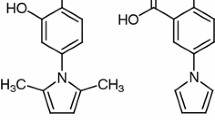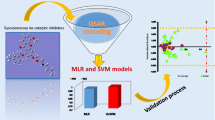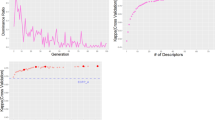Abstract
The quantitative structure–activity relationship (QSAR) of the novel 4-aminopyrimidine-5-carbaldehyde oxime derivatives as effective and selective inhibitors of potent VEGFR-2 was studied. A suitable set of the molecular descriptors was calculated, and the most impressive descriptors were subsequently selected using genetic algorithm (GA) variable selection approach. To construct robust models, the GA was combined with multiple linear regression and support vector machine, respectively, as GA-MLR and GA-SVM. The predictive quality of the QSAR model was examined for an external set of six compounds, randomly chosen out of 32 compounds in the original data set. The accuracy of the proposed models was further confirmed using cross-validation, validation through an external test set and Y-randomization approaches. Based on the selected descriptors, we have identified some key features in the 4-aminopyrimidine-5-carbaldehyde oxime derivatives that are responsible for potent VEGFR-2 inhibitory activity. The analyses may be used to design more potent 4-aminopyrimidine-5-carbaldehyde oxime derivatives and predict their activities prior to synthesis.






Similar content being viewed by others
References
Adimi M, Salimi M, Nekoei M, Pourbasheer E, Beheshti A (2012) A quantitative structure-activity relationship study on histamine receptor antagonists using the genetic algorithm-multi-parameter linear regression method. J Serb Chem Soc 77(5):639–650. doi:10.2298/jsc110804205a
Agrawal VK, Khadikar PV (2001) QSAR prediction of toxicity of nitrobenzenes. Bioorg Med Chem 9(11):3035–3040. doi:10.1016/s0968-0896(01)00211-5
Ahmad S, Gromiha MM (2003) Design and training of a neural network for predicting the solvent accessibility of proteins. J Comput Chem 24(11):1313–1320. doi:10.1002/jcc.10298
Aires-de-Sousa J, Hemmer MC, Gasteiger J (2002) Prediction of 1H-NMR chemical shifts using neural networks. Anal Chem 74(1):80–90. doi:10.1021/ac010737m
Alsberg BK, Marchand-Geneste N, King RD (2000) A new 3D molecular structure representation using quantum topology with application to structure-property relationships. Chemom Intell Lab Syst 54:75–91
Baumann K (2005) Chance correlation in variable subset regression: influence of the objective function, the selection mechanism, and ensemble averaging. QSAR Comb Sci 24(9):1033–1046. doi:10.1002/qsar.200530134
Beheshti A, Pourbasheer E, Nekoei M, Banaei A (2012) Quantitative structure-activity relationship study of amino acid derivatives as histone deacetylase inhibitors using the genetic algorithm-multiple linear regression. Anal Chem Lett 2:33–43
Burbidge R, Trotter M, Buxton B, Holden S (2001) Drug design by machine learning: support vector machines for pharmaceutical data analysis. Comput Chem 26(1):5–14. doi:10.1016/s0097-8485(01)00094-8
Byvatov E, Fechner U, Sadowski J, Schneider G (2003) Comparison of support vector machine and artificial neural network systems for drug/nondrug classification. J Chem Inf Comput Sci 43(6):1882–1889. doi:10.1021/ci0341161
Caballero J, Fernandez M (2006) Linear and nonlinear modeling of antifungal activity of some heterocyclic ring derivatives using multiple linear regression and Bayesian-regularized neural networks. J Mol Model 12(2):168–181. doi:10.1007/s00894-005-0014-x
Carmeliet P, Jain RK (2000) Angiogenesis in cancer and other diseases. Nature 407(6801):249–257
Chen HF (2008) Quantitative predictions of gas chromatography retention indexes with support vector machines, radial basis neural networks and multiple linear regression. Anal Chim Acta 609(1):24–36. doi:10.1016/j.aca.2008.01.003
Cortes C, Vapnik V (1995) Support-vector networks. Mach Learn 20:273–297
Depczynski U, Frost VJ, Molt K (2000) Genetic algorithms applied to the selection of factors in principal component regression. Anal Chim Acta 420:217–227
Dolatabadi M, Nekoei M, Banaei A (2010) Prediction of antibacterial activity of pleuromutilin derivatives by genetic algorithm-multiple linear regression (GA-MLR). Monatsh Chem 141(5):577–588. doi:10.1007/s00706-010-0299-z
Eriksson L, Gottfries J, Johansson E, Wold S (2004) Time-resolved QSAR: an approach to PLS modelling of three-way biological data. Chemom Intell Lab Syst 73(1):73–84. doi:10.1016/j.chemolab.2004.04.004
Fatemi MH, Gharaghani S (2007) A novel QSAR model for prediction of apoptosis-inducing activity of 4-aryl-4-H-chromenes based on support vector machine. Bioorg Med Chem 15(24):7746–7754. doi:10.1016/j.bmc.2007.08.057
Fernandez M, Caballero J (2006) Bayesian-regularized genetic neural networks applied to the modeling of non-peptide antagonists for the human luteinizing hormone-releasing hormone receptor. J Mol Graph Model 25(4):410–422. doi:10.1016/j.jmgm.2006.02.005
Fernandez M, Caballero J (2007) QSAR modeling of matrix metalloproteinase inhibition by N-hydroxy-alpha-phenylsulfonylacetamide derivatives. Bioorg Med Chem 15(18):6298–6310. doi:10.1016/j.bmc.2007.06.014
Ferrara N (1999) Molecular and biological properties of vascular endothelial growth factor. J Mol Med 77(7):527–543
Ferrara N, Gerber HP, LeCouter J (2003) The biology of VEGF and its receptors. Nat Med 9(6):669–676. doi:10.1038/nm0603-669
Folkman J (1995) Angiogenesis in cancer, vascular, rheumatoid and other disease. Nat Med 1(1):27–31
Gunn SR (1997) Support vector machines for classification and regression. University of Southampton, Southampton
Guo SC, Colbert LS, Fuller M, Zhang YY, Gonzalez-Perez RR (2010) Vascular endothelial growth factor receptor-2 in breast cancer. BBA-Rev Cancer 1806(1):108–121. doi:10.1016/j.bbcan.2010.04.004
Hemmateenejad B, Safarpour MA, Miri R, Nesari N (2005) Toward an optimal procedure for PC-ANN model building: prediction of the carcinogenic activity of a large set of drugs. J Chem Inf Model 45(1):190–199. doi:10.1021/ci049766z
Holmes K, Roberts OL, Thomas AM, Cross MJ (2007) Vascular endothelial growth factor receptor-2: structure, function, intracellular signalling and therapeutic inhibition. Cell Signal 19(10):2003–2012. doi:10.1016/j.cellsig.2007.05.013
Huang SL, Li RH, LaMontagne KR, Greenberger LM, Connolly PJ (2011) 4-Aminopyrimidine-5-carbaldehyde oximes as potent VEGFR-2 inhibitors. Part II. Bioorg Med Chem Lett 21(6):1815–1818. doi:10.1016/j.bmcl.2011.01.053
Hunger J, Huttner G (1999) Optimization and analysis of force field parameters by combination of genetic algorithms and neural networks. J Comput Chem 20:455–471
Jouanrimbaud D, Massart DL, Leardi R, deNoord OE (1995) Genetic algorithms as a tool for wavelength selection in multivariate calibration. Anal Chem 67:4295–4301
Kar S, Roy K (2010) QSAR modeling of toxicity of diverse organic chemicals to Daphnia magna using 2D and 3D descriptors. J Hazard Mater 177(1–3):344–351. doi:10.1016/j.jhazmat.2009.12.038
Khadikar PV, Phadnis A, Shrivastava A (2002) QSAR study on toxicity to aqueous organisms using the PI index. Bioorg Med Chem 10(4):1181–1188. doi:10.1016/s0968-0896(01)00375-3
Khajeh A, Modarress H (2012) Quantitative structure-property relationship prediction of liquid heat capacity at 298.15 K for organic compounds. Ind Eng Chem Res 51(17):6251–6255. doi:10.1021/ie202153e
Liu HX, Zhang RS, Luan F, Yao XJ, Liu MC, Hu ZD, Fan BT (2003a) Diagnosing breast cancer based on support vector machines. J Chem Inf Comput Sci 43(3):900–907. doi:10.1021/ci0256438
Liu HX, Zhang RS, Yao XJ, Liu MC, Hu ZD, Fan BT (2003b) QSAR study of ethyl 2-(3-methyl-2,5-dioxo(3-pyrrolinyl))amino-4-(trifluoromethyl) pyrimidine-5-carboxylate: an inhibitor of AP-I and NF-kappa B mediated gene expression based on support vector machines. J Chem Inf Comput Sci 43(4):1288–1296. doi:10.1021/ci0340355
Liu HX, Zhang RS, Yao XJ, Liu MC, Hu ZD, Fan BT (2004) Prediction of the isoelectric point of an amino acid based on GA-PLS and SVMs. J Chem Inf Comput Sci 44(1):161–167. doi:10.1021/ci034173u
Liu J, Zhou L, Zuo ZL (2008) Antibacterial activities of carbapenem derivatives and quantitative structure-activity relationship for drug design. QSAR Comb Sci 27(10):1216–1226. doi:10.1002/qsar.200710104
Lohela M, Bry M, Tammela T, Alitalo K (2009) VEGFs and receptors involved in angiogenesis versus lymphangiogenesis. Curr Opin Cell Biol 21(2):154–165. doi:10.1016/j.ceb.2008.12.012
Mohammadhosseini M, Deeb O, Alavi- Gharabagh A, Nekoei M (2012) Exploring novel QSRRs for simulation of gas chromatographic retention indices of diverse sets of terpenoids in Pistacia lentiscus L. essential oil using stepwise and genetic algorithm multiple linear regressions. Anal Chem Lett 2:80–102
Nekoei M, Salimi M, Dolatabadi M, Mohammadhosseini M (2011a) Prediction of antileukemia activity of berbamine derivatives by genetic algorithm-multiple linear regression. Monatsh Chem 142(9):943–948. doi:10.1007/s00706-011-0510-x
Nekoei M, Salimi M, Dolatabadi M, Mohammadhosseini M (2011b) A quantitative structure-activity relationship study of tetrabutylphosphonium bromide analogs as muscarinic acetylcholine receptors agonists. J Serb Chem Soc 76(8):1117–1127. doi:10.2298/jsc101122102s
Niani C, Wencong L, Jie Y, Gozheng L (2004) Support vector machine in chemistry. World Scientific Publishing Co. Pet. Ltd., Shanghai
Pandey VK, Tusi Z, Tandon M, Joshi MN, Bajpai SK (2003) Synthesis of thiadiazolo-S-triazines for their antiviral activity based on QSAR studies. Indian J Chem Sect B 42(10):2583–2588
Pourbasheer E, Riahi S, Ganjali MR, Norouzi P (2010) Quantitative structure-activity relationship (QSAR) study of interleukin-1 receptor associated kinase 4 (IRAK-4) inhibitor activity by the genetic algorithm and multiple linear regression (GA-MLR) method. J Enzyme Inhib Med Chem 25(6):844–853. doi:10.3109/14756361003757893
Riahi S, Ganjali MR, Pourbasheer E, Norouzi P (2008) QSRR study of GC retention indices of essential-oil compounds by multiple linear regression with a genetic algorithm. Chromatographia 67(11–12):917–922. doi:10.1365/s10337-008-0608-4
Riahi S, Pourbasheer E, Ganjali MR, Norouzi P (2009) Investigation of different linear and nonlinear chemometric methods for modeling of retention index of essential oil components: concerns to support vector machine. J Hazard Mater 166(2–3):853–859. doi:10.1016/j.jhazmat.2008.11.097
Stitson MO, Weston JAE, Gammerman A, Vork V, Vapnik VN (1996) Theory of support vector machines, technical report CSD-TR-96-17. Department of Computer Science, Royal Holloway College, University of London
Toropov AA, Benfenati E (2006a) QSAR models for Daphnia toxicity of pesticides based on combinations of topological parameters of molecular structures. Bioorg Med Chem 14(8):2779–2788. doi:10.1016/j.bmc.2005.11.060
Toropov AA, Benfenati E (2006b) QSAR models of quail dietary toxicity based on the graph of atomic orbitals. Bioorg Med Chem Lett 16(7):1941–1943. doi:10.1016/j.bmcl.2005.12.085
Tropsha A, Zhang WF (2001) Identification of the descriptor pharmacophores using variable selection QSAR: applications to database mining. Curr Pharm Des 7(7):599–612. doi:10.2174/1381612013397834
Vapnik VN (1995) The nature of statistical learning theory. Springer, Berlin
Vapnik NV (1998) Statistical learning theory. Wiley, New York
Vatani A, Mehrpooya M, Gharagheizi F (2007) Prediction of standard enthalpy of formation by a QSPR model. Int J Mol Sci 8(5):407–432. doi:10.3390/i8050407
Waller CL, Bradley MP (1999) Development and validation of a novel variable selection technique with application to multidimensional quantitative structure–activity relationship studies. J Chem Inf Comput Sci 39:345–355
Xu J, Zhang H, Wang L, Liang GJ, Wang LX, Shen XL, Xu WL (2010) QSPR study of absorption maxima of organic dyes for dye-sensitized solar cells based on 3D descriptors. Spectrochim Acta Mol Biomol Spectros 76(2):239–247. doi:10.1016/j.saa.2010.03.027
Zhao WG, Wang HG, Li ZM, Yang Z (2006) Synthesis and antiviral activity against tobacco mosaic virus and 3D-QSAR of alpha-substituted-1,2,3-thiadiazoleacetamides. Bioorg Med Chem Lett 16(23):6107–6111. doi:10.1016/j.bmcl.2006.05.043
Acknowledgments
The authors express their special thanks to the office for research affair of Islamic Azad University of Shahrood for financial supports of the research proposal and the time dedicated for performance the calculations of the study.
Author information
Authors and Affiliations
Corresponding author
Rights and permissions
About this article
Cite this article
Nekoei, M., Mohammadhosseini, M. & Pourbasheer, E. QSAR study of VEGFR-2 inhibitors by using genetic algorithm-multiple linear regressions (GA-MLR) and genetic algorithm-support vector machine (GA-SVM): a comparative approach. Med Chem Res 24, 3037–3046 (2015). https://doi.org/10.1007/s00044-015-1354-4
Received:
Accepted:
Published:
Issue Date:
DOI: https://doi.org/10.1007/s00044-015-1354-4




